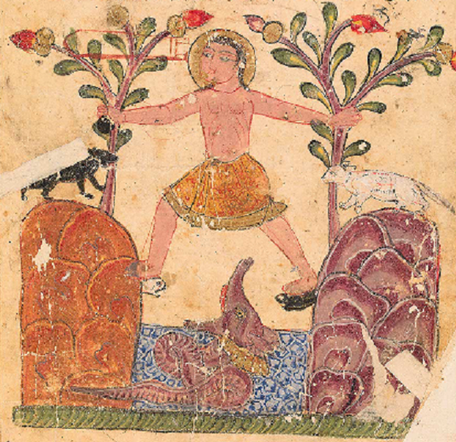القصة الإطار والجواب السردي في كليلة ودمنة
Frame Story and Narrative Response in "Kalīla and Dimna"
DOI:
https://doi.org/10.5617/jais.10121Abstract
The inception of frame stories in the literary Arabic tradition, I argue, originates in, first, what I call “assembly narrative” (al-sard al-majlisī), which ensued during the oral phase of the Arabic language in evening gatherings in the desert’s open space, and second, in a specific discursive type (nawʿ khiṭābī), “questions and answers” (al-suʾālāt wa-l-ajwiba), which dominated Arabic literary writings around the tradition of the prophet Muḥammad (ḥadīth) during the phase of writings and then expanded to encompass multiple topics. I argue that the roots of the latter can be found in the Accounts of ʿUbayd b. Shariyya al-Jurhumī, in which Muʿāwiya b. Abī Sufyān quizzes ʿUbayd on pre-Islamic Arab history.
With the “assembly narrative,” the phenomenon of exchanging stories (taḥākī) appears in which an assembly participant is granted the opportunity to present an account (khabar), a tale (ḥikāya) or a story (qiṣṣa) through alternation, based on resembling or opposing themes; thus, stories and accounts generate other stories and accounts, producing knowledge and entertainment. As for the other type, “questions and answers,” with it emerged the need to inquire about historical, cultural, religious, and ethical issues from a known personality because of his/her knowledge of or familiarity with a specific topic and the trust toward what s/he offers regarding informative or narrative responses to the raised issues.
The questions took several forms like “What happened (to the character that will dominate in the narrative framing)?,” “How did that happen?”, etc., while the taḥākī (exchange of stories) produced all the embedded stories (qiṣaṣ muḍammana) that materialize as a narrative response (jawāb sardī) to questions of a narrative or documentary nature. In light of this concept I will finally analyze the structures, relations, and functions that characterize Kalīla wa-Dimna from a postclassical narratological perspective.
Key words: Framing, embedding, taḥākī, narrative response, structures, relations, functions, Kalīla wa-Dimna
Downloads
Published
How to Cite
Issue
Section
License
For content published in editions of JAIS before 2002, copyright belongs to the author. Content published between 2002 and 2017 is copyrighted by Edinburgh University Press (reproduced on FRITT with permission). Text and other material published in these journal volumes can only be shared and republished with written permission from the rights holders.
Starting from 2017, the content published in JAIS is - unless otherwise is stated - licensed through Creative Commons License Attribution 4.0: https://creativecommons.org/licenses/by/4.0/. Through this licence content can be copied and distributed but also remixed, transformed and built upon for any purpose under the following conditions:
Attribution — You must give appropriate credit to the creators of materials published in JAIS, provide a link to the license, and indicate if changes were made. You may do so in any reasonable manner, but not in any way that suggests the licensor endorses you or your use.
No additional restrictions — You may not apply legal terms or technological measures that legally restrict others from doing anything the license permits.
Notice: No warranties are given. The license may not give you all of the permissions necessary for your intended use. For example, other rights such as publicity, privacy, or moral rights may limit how you use the material.
Authors who publish in JAIS accept the following conditions:
Author(s) retains copyright to the article and give JAIS right to first publication while the article is licensed under the Creative Commons CC BY 4.0. This license allows sharing the article for non-commercial purposes, as long as the author and first publishing place JAIS are credited. The license does not allow others to publish adapted versions of the article without the author's permission.
The author is free to publish and distribute the work/article after publication in JAIS, as long as the journal is referred to as the first place of publication. Submissions that are under consideration for publication or accepted for publication in JAIS cannot simultaneously be under consideration for publication in other journals, anthologies, monographs or the like. By submitting contributions, the author accepts that the contribution is published in both digital and printed editions of JAIS.



